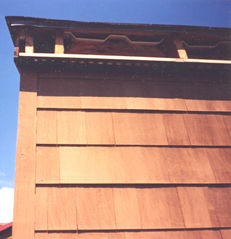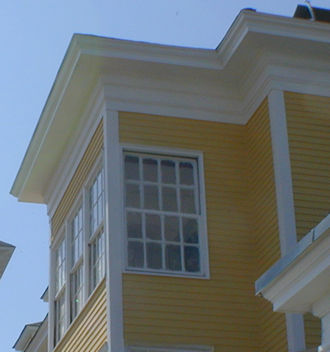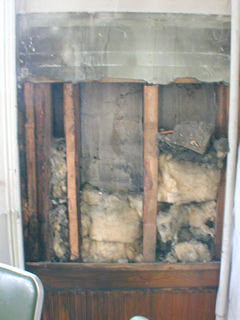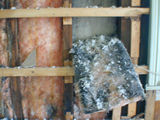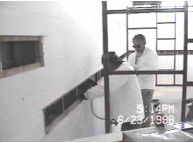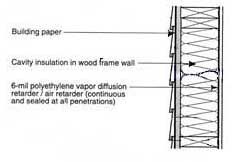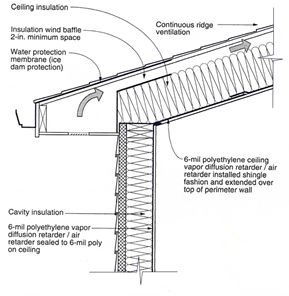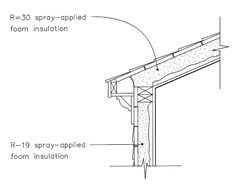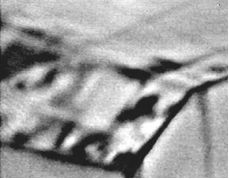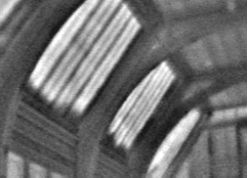|
||||||||||||||||||||||||||||||||||||||||||||||
|
||||||||||||||||||||||||||||||||||||||||||||||
|
|
The Use of Polyurethane Foam Technology in Historic
| ||||||||||||||||||||||||||||||||||||||||||||
|
In some cases, where the use of an historic building is being changed, keeping the building un-insulated is chosen as the best solution for maintaining the historic character of the structure because methods of improving energy performance, without major changes or damage to the building, are unknown. This choice limits the use of the building, wastes energy, or may lead to various types of building failures if the use of the building creates new environmental conditions for the structure. Most renovations and energy-conservation upgrades of historic and landmark buildings are compromised by the commitment to maintain the original character and architectural detailing of the structure. Achieving modern thermal performance requirements poses a real challenge for these older buildings which new construction does not have; modern framing provides space for more insulation and roof ventilation, and current building practice includes provisions for vapor and air-leakage control. Properly installed polyurethane foam systems can be utilized to overcome many of these limitations, allowing historic structures to maintain their aesthetic charm while meeting modern energy conservation and climate-control needs. Polyurethane’s unique combination of high R-value, vapor control, and air sealing properties allow designers to meet modern building envelope standards in the smaller cavity sizes common in most retrofit projects. This especially applies to roof applications where not only are the cavity sizes too small, but ventilation is difficult or impossible due to the constraints of the existing soffit and ridge details.
II. Why is polyurethane foam effective for protecting historic buildings?
|
Polyurethane foams offer more than just R-value. While it is important to prevent conductive losses through the thermal envelopes of historic buildings, many building failures are due to air flow through building cavities. In heating climates, buildings without air barriers allow air leaking outward (ex-filtration) from warm, moist conditioned (interior) spaces. Moisture-laden air reaches cold surfaces of the building cavities (usually near the outside) causing condensation. Severe moisture accumulation can produce mold, mildew, and rot. Builders who have taken apart an older building with batt or loose-fill insulation have probably seen black areas (mold and mildew) in the insulation along air-leakage paths, but not in more air-tight sections.
Air leaking inward (infiltration) can cause frozen pipes, foundation failures, discomfort, and excessive fuel bills. Vapor migration through building cavities can also contribute to building failures, although diffusion is often a less significant source of moisture than convection. All properly installed polyurethane foam systems provide air sealing and viable vapor retarders (closed-cell urethanes) for most building climates. Reducing the likelihood of air leakage and moisture flow reduces the susceptibility of the building envelope to vermin and indoor air quality problems. Roofs insulated with urethanes do not require ventilation. Many successful un-vented applications exist without problematic ice dams or premature deterioration of the roof materials or structure. Foamed-in-place urethanes have been used for over fifty years in retrofit applications and have a good track record of providing successful solutions for improving building envelopes and isolating interior conditioned spaces to support environmental control systems.
III. What is polyurethane foam?
Polyurethane foams are a family of plastics that are “blown” with various gases to create light-weight “foamed” insulation and sealant materials. Rigid polyurethane foams are commonly used in high-performance refrigerators, freezers, and hot water heaters. Flexible urethanes are used for pillows, furniture cushions, carpet pads, and packaging.
Urethanes are not to be confused with expanded or extruded polystyrenes or urea formaldehyde foams. Urea formaldehyde foam was prone to out gassing and dimensional stability problems when processed incorrectly, and unfortunately continues to be associated with all foam insulation products. Polystyrenes (EPS) are commonly available as expanded bead board (white molded packaging) or as blue or pink extruded board stock, commonly used as exterior below-grade and under-slab insulation. These materials cannot be practically field-processed from their raw materials.
IV. What are the advantages of polyurethane foam?
Many chemical formulations for urethanes are available which can be:
-
field-processed using an number of installation techniques
-
produced to exhibit a wide range of physical properties
-
produced on-site with a number of industry-standard delivery systems
The most significant advantage of polyurethane foams is that they can be field-processed and field-applied using reasonably practical methods with the expectation of consistently producing a quality product. Polyurethane technology has advanced to the point where numerous delivery systems and chemical formulations offer the versatility needed to answer most thermal envelope problems.
|
||||
Installation techniques include spray, injection, and small scale “caulking” methods. Spray techniques produce monolithic, air-tight applications that can continuously coat and seal even the most complicated surfaces. Polyurethane foam bonds to almost any dry substrate and provides some reinforcement or stabilization of the material to which it is applied. Injection techniques provide cavity-fill capability, while avoiding the removal of historic and otherwise stable interior and exterior finishes.
|
Densities and cell configurations can be controlled to vary the strength, permeability, and dimensional stability of the foam. Urethanes are now available in both open and closed-cell formulations. Closed-cell foams have higher R-values and lower perm ratings than open-cell foams, but open-cell foams are less expensive and therefore appropriate in situations where large cavities must be filled and permeability is not an issue. Polyurethane foams have the highest R-value available in a field-processed insulation product. Low-conductivity blowing agents used in the production of closed-cell foams yield higher R-values (6.5 to 7.3 per inch) than other common insulation materials. This allows adequate R-values in undersized wall and roof cavities. Product data sheets indicating physical properties and processing requirements are available on line.
Additional information on R-values, blowing agents, thermal barriers, sound control, and permeability for polyurethane foams is also available on this web site.
|
The installed products also provide superior thermal envelope performance by reducing air infiltration, resisting performance degradation caused by convection and wind, and vapor control in a one-step process. To put this in perspective, installing 3" of polyurethane foam in/on a 3" wall cavity is equivalent to a vapor retarder, 6" of batt insulation, and an air-barrier material with all of the joints sealed. A 5" application of polyurethane foam installed between 5" rafters directly at the underside of the roof sheathing is equivalent to a vapor retarder with all of the joints sealed, 12" of batt insulation, vent chutes, room for an air space, soffit vents, and ridge vents.
Urethanes are also available as rigid foam board insulation or in the form of pre-manufactured structural insulated panels (SIPs). These materials have the same advantages as field-applied polyurethane foams, with the exception of the inherent air-sealing advantages at the panel joints. For this reason, many applications include a combination of rigid foam board or SIPs with polyurethane sealant at the panel joints.
Another advantage of using polyurethane foam in restoration work is the ability to perform non-destructive quality assurance procedures at any phase of the construction. When polyurethane foam is spray-applied in open cavities, testing can be performed before the installation of the interior finishes. Batt and loose-fill insulation materials rely on vapor barriers and interior finishes to create a complete thermal envelope system. As polyurethane foams provide all three of the components of the thermal envelope - insulation, air sealing, and vapor control - testing can verify envelope performance while the foam barrier is still accessible. This allows the installer to correct any deficiencies in the installation while the work is in progress, avoiding the removal of finishes to access problem areas in a later phase of the construction. When foam is installed in blind, cavity-fill installations, testing can be performed with the existing finishes in place, as the work progresses. The exothermic heat of polyurethane’s chemical reaction is hot enough, even in warm weather, to allow thermographic inspection and recording. Examples of non-destructive quality assurance testing with infrared thermography, pressurized fog air-leakage testing, and temperature and humidity monitoring are included in some of the case studies below.
|
This selection of installation techniques, chemical formulations that provide a wide range of physical properties, and quality assurance techniques provide the flexibility needed to address even the most complicated set of building conditions and building science objectives. A paper on the use of infrared testing for the quality assurance of polyurethane foams (published in the proceeds of the SPIE Thermosense XI Conference) is available on this site.
V. What are the disadvantages of polyurethane foam?
The primary disadvantage of polyurethane foams is cost. Urethanes are significantly more expensive than recycled or mineral-based products that do not require high-tech installation equipment. However, this cost factor is weighed on a case-by-case basis against lower-cost insulation systems that may still require expensive air/vapor-leakage control and ventilation measures to complete the thermal envelope. In some cases, there are no viable alternatives for providing these critical air/vapor control components with other methods. Where cavity sizes are too small, higher R-values provided by urethanes may provide energy savings sufficient to offset the initial cost difference. This is often true in roof configurations where there isn’t enough space for higher R-values and ventilation is difficult or impossible. Foamed plastics also have fire protection issues that must be addressed. In closed cavities, the interior finishes usually meet the code requirements for a thermal barrier, but exposed applications in attics, unfinished basements, and crawl spaces may require additional thermal barrier installations, adding to the costs. Ventilation and process temperature requirements may be more strict for urethanes than for other types of insulation, depending on the application type. Finally, polyurethane foams bonded directly to a structure may raise concerns about the reversibility of renovation efforts. Some historic projects consider this factor in product selection. Methods are available which keep the installation reversible, but still provide effective building performance. Examples of these are included in some of the case studies.
MSDS sheets indicating the safety of installed polyurethane foams are available at this site.
Continue on to Polyurethane Foam Applications




